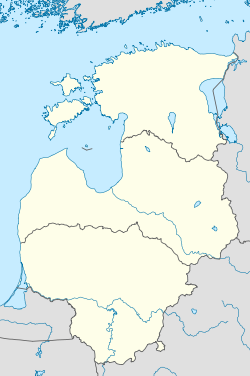Vilnius | |
|---|---|
| Nickname(s): | |
| Motto(s): Unitas, Justitia, Spes (Latin: Unity, Justice, Hope) | |
 Interactive map of Vilnius | |
| Coordinates: 54°41′14″N 25°16′48″E / 54.68722°N 25.28000°E | |
| Country | |
| County | Vilnius County |
| Municipality | Vilnius |
| Capital of | Lithuania |
| First mentioned | 1323 |
| Granted city rights | 1387 |
| Elderships | |
| Government | |
| • Type | Mayor–council government |
| • Body | City council |
| • Mayor | Valdas Benkunskas |
| Area | |
| 401 km2 (155 sq mi) | |
| • Urban | 350 km2 (140 sq mi) |
| • Metro | 9,730 km2 (3,760 sq mi) |
| Elevation | 112 m (367 ft) |
| Population (1 July 2024)[9] | |
| 605,270 | |
| • Rank | (35th in EU) |
| • Density | 1,560/km2 (4,000/sq mi) |
| • Urban | 747,864[8] |
| • Urban density | 2,000/km2 (5,000/sq mi) |
| • Metro | 853,656[6][7] |
| • Metro density | 93/km2 (240/sq mi) |
| Demonym(s) | Vilnian (English) vilniečiai (Lithuanian) |
| GDP | |
| • Metro | €29.4 billion (US$31 billion) (2022) |
| • Per capita | €35,300 (US$37,200) (2022) |
| Time zone | UTC+2 (EET) |
| • Summer (DST) | UTC+3 (EEST) |
| Postal code | 01001–14191 |
| Area code | (+370) 5 |
| City budget | €1.4 billion[12] |
| HDI (2021) | 0.913[13] – very high |
| Climate | Dfb |
| Website | vilnius |
| Official name | Historic Centre of Vilnius |
| Type | Cultural |
| Criteria | ii, iv |
| Designated | 1994 (18th session) |
| Reference no. | [14] |
| UNESCO region | Europe |
Vilnius (/ˈvɪlniəs/ VIL-nee-əs, Lithuanian: [ˈvʲɪlʲnʲʊs] ), previously known in English as Vilna, is the capital of and largest city in Lithuania and the second-most-populous city in the Baltic states. The city's estimated July 2024 population was 605,270, and the Vilnius urban area (which extends beyond the city limits) has an estimated population of 708,627.[15]
Vilnius is notable for the architecture of its Old Town, considered one of Europe's largest and best-preserved old towns. The city was declared a UNESCO World Heritage Site in 1994.[16][17][18][19] The architectural style known as Vilnian Baroque is named after the city, which is farthest to the east among Baroque cities and the largest such city north of the Alps.[20][21]
The city was noted for its multicultural population during the Polish–Lithuanian Commonwealth, with contemporary sources comparing it to Babylon. Before World War II and the Holocaust, Vilnius was one of Europe's most important Jewish centers. Its Jewish influence has led to its being called "the Jerusalem of Lithuania", and Napoleon called it "the Jerusalem of the North"[22] when he passed through in 1812.
Vilnius was a 2009 European Capital of Culture with Linz in Austria.[23] In 2021, the city was named one of fDi's 25 Global Cities of the Future.[24] Vilnius is considered a global financial centre, ranked 76th globally and 29th in Europe on the Global Financial Centres Index.[25] It hosted the 2023 NATO Summit. Vilnius is a member of Eurocities[26] and the Union of Capitals of the European Union (UCEU).[27]
- ^ "Vilnius: In Search of the Jerusalem of Lithuania – Lithuanian Jewish Community". lzb.lt. 18 November 2016. Archived from the original on 14 April 2024. Retrieved 5 March 2021.
- ^ Widespread use of the nickname from the 16th century to this day as a reference to the many Catholic churches and monasteries in Vilnius and overall religious atmosphere in the centre. This nickname was/is used not only by foreigners but also by the local population. The 19th-century Lithuanian cultural figure Dionizas Poška called Vilnius "Rome of the North", as, according to him, Vilnius is "the old religious centre, that transformed from a pagan city into the bastion of Christianity". D. Poška, Raštai, Vilnius, 1959, p. 67
- ^ Cultural newspaper, It has been published in Vilnius since 1990, is named "Šiaurės Atėnai" (The Athens of the North) as a reference to one of Vilnius's nicknames, which was widespread in the first half of the 19th century and the first half of the 20th, mostly because of Vilnius University. During the interwar period, a Polish scientific newspaper published in Vilnius was also named "Atheneum Wileńskie".
- ^ Especially in the 16th–17th centuries, Vilnius was called the ‘New Babylon’ because of the many languages spoken there, as well as its many religions (various Christian denominations as well as Jews and a Muslim Tatar community). E.g.: S. Bodniak, "Polska w relacji włoskiej z roku 1604", Pamiętnik biblioteki kórnickiej, 2, (Kórnik, 1930), p. 37.
- ^ This nickname was very popular among the Lithuanian nobility, citizens of Vilnius, and poets, especially during the Baroque period. Many poets of the period, including Maciej Kazimierz Sarbiewski, called Vilnius "the capital of Palemon" or "the city of Palemon". Živilė Nedzinskaitė, Vilnius XVII–XVIII a. LDK lotyniškojoje poezijoje, Acta Academiae Artium Vilnensis, Vilnius, 2010, p. 16; Eugenija Ulčinaitė, Motiejus Kazimieras Sarbievijus: Antikos ir krikščionybės sintezė; Vilniaus pasveikinimas, Lietuvių literatūros ir tautosakos institutas, Vilnius, 2001, pp. 47, 59, 61, 63; etc.
- ^ with Vilnius county
- ^ "GYVENTOJAI PAGAL TAUTYBĘ, GIMTĄJĄ KALBĄ IR TIKYBĄ : Lietuvos Respublikos 2011 metų visuotinio gyventojų ir būstų surašymo rezultatai" (PDF). Ops.stat.gov.lt. Retrieved 18 October 2018.
- ^ "Eurostat". eurostat.ec.europa.eu.
- ^ "Resident population on 1 July". osp.stat.gov.lt. 19 July 2024.
- ^ "Gross domestic product (GDP) at current market prices by metropolitan regions". ec.europa.eu.
- ^ "Sostinės regiono BVP gyventojui pernai 1,9 karto viršijo likusios Lietuvos", www.vz.lt
- ^ 2024 metų asignavimai pagal valdytojus
- ^ Sub-national HDI. "Area Database – Global Data Lab". hdi.globaldatalab.org.
- ^ "Vilnius Historic Centre". UNESCO World Heritage Centre. Retrieved 1 January 2022.
- ^ "Resident population by county and municipality at the middle of the year". Vilnius. Statistics Department of Lithuania. 1 July 2024. Retrieved 19 July 2024.
- ^ "Lithuania". UNESCO World Heritage Centre. Archived from the original on 14 January 2018.
- ^ Cite error: The named reference
TheCapitalwas invoked but never defined (see the help page). - ^ Cite error: The named reference
VWHwas invoked but never defined (see the help page). - ^ Cite error: The named reference
Lurkwas invoked but never defined (see the help page). - ^ "Baroque Vilnius". VisitWorldHeritage.com. Archived from the original on 12 February 2023. Retrieved 12 February 2023.
- ^ Cite error: The named reference
unescowas invoked but never defined (see the help page). - ^ Steele, Jonathan (19 June 2008). "In the Jerusalem of the North, the Jewish story is forgotten". Opinion. The Guardian. Archived from the original on 14 January 2018. Retrieved 4 March 2018.
- ^ "Ex-Post Evaluation of 2009 European Capitals of Culture" (PDF). ECOTEC Research and Consulting Ltd. Archived (PDF) from the original on 14 January 2018.
- ^ "fDi's Global Cities of the Future 2021/22 — overall winners". fdiintelligence. fDi Intelligence A service from The Financial Times Ltd. Retrieved 11 October 2022.
- ^ The Global Financial Centres Index 28, September 2020, page 5
- ^ "EUROCITIES – the network of major European cities". Eurocities. Archived from the original on 24 August 2020. Retrieved 8 November 2011.
- ^ "Union of Capitals of the European Union". Union of Capitals of the European Union (UCEU). Archived from the original on 20 October 2011. Retrieved 8 November 2011.












